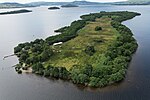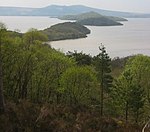Endrick Water
Rivers of Stirling (council area)Rivers of West DunbartonshireScotland river stubsScottish Site of Special Scientific Interest stubsSites of Special Scientific Interest in Scotland ... and 1 more
Stirling (council area) geography stubs

The Endrick Water or River Endrick (Scottish Gaelic: Eunarag) is a river which flows into the eastern end of Loch Lomond, Scotland. Its drainage basin covers a large part of the west of Stirling District. The Burnfoot Burn rising on the southern slopes of the Gargunnock Hills and the Backside Burn rising on the eastern slopes of the Fintry Hills combine to form the Endrick Water which flows south before turning sharply westwards at the foot of the western dam of Carron Valley Reservoir. The river flows through Strathendrick, the village of Fintry and past Balfron and Drymen before entering Loch Lomond.
Excerpt from the Wikipedia article Endrick Water (License: CC BY-SA 3.0, Authors, Images).Endrick Water
Geographical coordinates (GPS) Address Nearby Places Show on map
Geographical coordinates (GPS)
| Latitude | Longitude |
|---|---|
| N 56.07162 ° | E -4.5259 ° |
Address
Balmaha
G63 0JQ
Scotland, United Kingdom
Open on Google Maps









